Canadian Forces Provost Marshal Annual Report 2023-2024
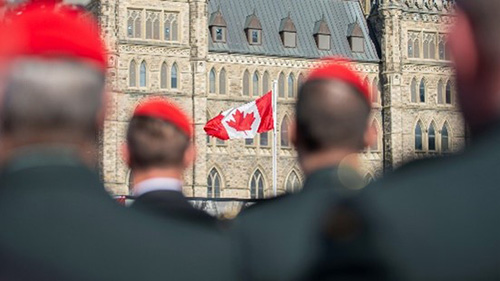
Canada’s Military Police
Highly skilled soldiers and police officers serving in Canada and abroad
Office of the Canadian Forces Provost Marshal and Military Police Group
2200 Walkley Road
Ottawa, ON, K1A 0K2
Telephone: 613-949-1000
Fax: 613 949-1637
Catalogue No. D3-13F-PDF
ISSN 2561-8490 (Online)
On this page
- Message from the Canadian Forces Provost Marshal and Commander of the Canadian Forces Military Police Group
- Message from the Canadian Forces Military Police Chief Warrant Officer
- Message from the Canadian Forces Military Police Branch Chief Warrant Officer
- Mission, Vision, MP Values and Core Functions
- Structure and Jurisdiction
- Office of the Canadian Forces Provost Marshal
- Office of the Deputy Canadian Forces Provost Marshal
- Highlights
- Military Police Strategic Plan 2019-2024
- Training Update
- Annex A: Investigation Statistics
- Definitions
- Annex B: The MP in Numbers
- Annex C: Map – CF MP Gp in Canada
- Annex D: Map – MP Support to CAF Named Operations
- Annex E: Map – Military Police Security Service (MPSS) Disposition
Message From the Canadian Forces Provost Marshal and Commander of the Canadian Forces Military Police Group

Caption
A picture of Brigadier-General Simon Trudeau, Canadian Forces Provost Marshal and and Commander Canadian Forces Military Police Group.
In my sixth year as Canadian Forces Provost Marshal (CFPM) and Commander Canadian Forces Military Police Group (CF MP Gp), it is my distinct privilege to be able to present this annual report, covering the period of 1 April 2023 to 31 March 2024.
This publication presents an opportunity to highlight the exceptional work undertaken by our entire MP team. Together we provide professional policing, security and detention services to the CAF and DND globally, across the full spectrum of military operations. To accomplish this complex task, we employ about 1750 military and civilian personnel. In short, this report demonstrates how the MP meet the mandated tasks assigned to us and how we intend to keep doing so in the future, while evolving in a changing security environment. You will also note some specific achievements of the past year and projects we are planning in the near and long term.
This year has been a year of collaboration, working alongside a wide range of allies, in the NATO MP community with civilian police agencies and other like-minded allies.
In September 2023, I assumed the role of President of the NATO MP Community of Interest (CoI) and Chair of the NATO MP and Gendarmerie Type Forces Chiefs annual conference during a ceremony in Bucharest, Romania. This peer elected two-year position is a great honour which was last held by a CFPM in 2011. I intend to maintain the cohesiveness of the community, helping it adapt to our current and ever-evolving circumstances, with an emphasis on MP support to warfighting in accordance with NATO’s renewed focus on Defence and Deterrence.
This year, we continued to implement Mme Arbour’s interim recommendation to transfer and refer Criminal Code sexual offences to civilian police while considering both the needs of the victims and the public interest.
The MP remain committed to the department-wide effort to ensure that DND/CAF is a safe and welcoming place for everyone. We will continue to work with our civilian police partners across the country to ensure justice is served and victims are treated with the respect and dignity they deserve.
There is much to be proud of this past year. From our receiving serial one of the new C24 MP service pistol, MP support to numerous CAF-named operations worldwide, to our focus on increasing output of the basic MP course at our Academy, it has been a busy and rewarding year.
I remain extremely proud of all the MP team members and their individual and collective contributions in moving the MP institution forward as a credible and reliable police service.
S. Trudeau Brigadier-General
Canadian Forces Provost Marshal and
Commander Canadian Forces Military Police Group
Message From the Canadian Forces Military Police Group Chief Warrant Officer
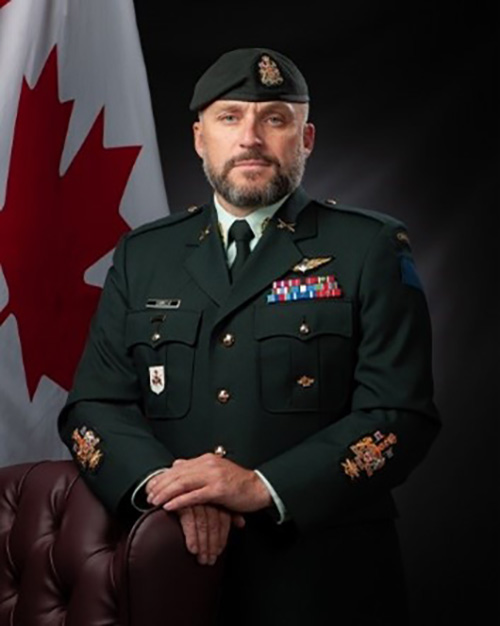
Caption
A picture of Chief Warrant Officer Isabelle, Canadian Forces Military Police Group Chief Warrant Officer.
As we conclude a year marked by significant achievements and progress, I am proud to be a part of this extraordinary team. As the representative of all MP Group members, I continue to be proud of the dedication, teamwork, and knowledge that so many of you possess. Each one of you is a valued member of the Group.
As Deputy Chair of the Honours and Awards Committee, I see firsthand how many of our members continue to demonstrate the highest level of Canadian military ethos. This past year, many of our members were awarded for their incredible work. Four members received the Order of Military Merit and several others received Chief of the Defence Staff (CDS) or Vice Chief of the Defence Staff (VCDS) Commendations. Finally, I want to congratulate the five recipients of the MP of the Year award.
This past year, we continued to strengthen the MP Branch with the appointment of the first full-time MP Branch CWO. This addition will enable several important files to get the attention they require. The MP Branch CWO and I will work closely, advancing files in a timely manner and implementing the succession plan for the Branch’s Non-Commissioned Members.
As we continue to modernize our force, we worked hard on updating Chapter 7 of the MP dress. By modernizing the uniform worn by our members, we hope to ensure that MP are in possession of a comfortable uniform that is also suited to their daily tasks. More information regarding these changes will be coming out in the upcoming fiscal year.
During the past year, we also continued our strong partnership with the Ukrainian MP to whom we provided our knowledge and tactical information in hopes of advancing their policing skills. This year, I was delighted to hear from the Ukrainian MP Commanding Officer that our teachings are deeply appreciated and have proven essential for the success of a wide array of their operations.
On the international stage, the CFPM and I participated in the NATO MP and Gendarmerie Type Forces Chiefs annual conference. During such time, we discussed the potential establishment of a Code of Conduct for non-commissioned members (NCM) of the Military Police within NATO.
This upcoming year presents a landscape rich with possibilities. With the continued professionalism and dedication that MP members demonstrate, I am certain MP will continue to adapt and progress as a united team.
S. Isabelle
Chief Warrant Officer
Canadian Forces Military Police Group Chief Warrant Officer
Message From the Military Police Branch Chief Warrant Officer

Caption
A picture of Chief Warrant Officer Dubé, Military Police Branch Chief Warrant Officer.
As I reflect on my first year as MP Branch CWO, I cannot help but feel honoured and privileged to have been selected for this critical Branch role. I can only hope that my broad range of experience and knowledge, acquired throughout my career, will serve me well as the Branch Chief.
The establishment of this position demonstrates the continued growth of the MP Branch. I am dedicated to working with a wide variety of our members on many different files, ensuring the outcome is what is best for MP.
As Branch CWO, I work on the health of the MP Branch as a whole. Right now, we find ourselves challenged by our retention and recruitment numbers. As the MP Branch continues to welcome change, I believe we will also be provided with the opportunity to strengthen our numbers.
I also work daily to ensure that the succession plan for our NCO’s is implemented well, taking into consideration, the wants and needs of many of our members. Although we have low numbers, I continue to work hard in ensuring that each member has the opportunity for growth and support.
Over the past couple of months, I had the opportunity to meet many of you and as we move forward, I aim to meet many more. Being able to watch many of you excel, completing your MP tasks, is truly inspiring.
This year I had the honour to present the newly qualified MP with their red berets, a significant milestone of their careers. I was pleased to be able to officially welcome you to the MP Branch.
In September, I had to the opportunity to participate in the police memorial parade. It was at this event that I had the privilege to assemble a formation of over 100 MP. What a great opportunity this was to meet many of you and to experience firsthand your professionalism.
This year, I was appointed co-chair of a NATO Military Police Ethics Advisory Team whereby I had the pleasure to represent the MP and collaborate with other senior Non-Commissioned Officers from eight different nations. Our goal remains to develop a Professional Code of Ethics for NATO MP. This will unify the Code for all deployed MP from NATO nations.
As MP Branch CWO, I am committed to all MP members and am immensely proud to work for you and for the Branch. S. Dubé Chief Warrant Officer Military Police Branch Chief Warrant Officer.
Mission, Vision, Mp Values and Core Functions
Mission
The CF MP Gp provides professional policing, security, and detention services to the CAF and DND globally, across the full spectrum of military operations.
Vision
The CF MP Gp will generate and sustain a credible and professional MP force properly resourced and enabled to conduct operations in the joint, combined environment through the implementation of its assigned mission and core functions.
Values
MP are expected to conform to the standards established in the MP Professional Code of Conduct (MPPCC), which embraces the following values:
- Loyalty
- Accountability
- Integrity/Ethics
- Competence
- Pride/Professionalism
Core Functions
- Policing
- Security
- Detention
- Operational Support Tasks for Environmental Commanders
Structure and Jurisdiction
Structure/independence
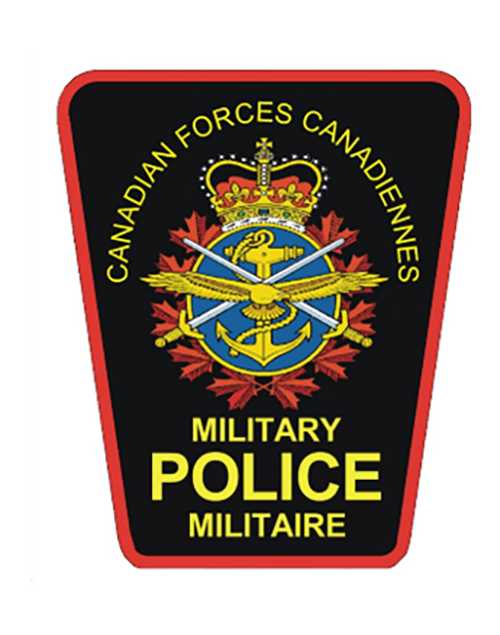
Caption
The Canadian Forces Military Police badge is worn on the Military Police Operational Patrol Dress. It has the crest of the Canadian Armed Forces in the centre on a black background with red trim. Above the crest says Canadian Forces in both French and English and the bottom of the patch says Military Police in both official languages.
Currently, the CFPM is appointed by the CDS and is the functional authority for MP within the CAF and the designated advisor to the CDS on policing matters. The person assigned to the position of the CFPM is also charged with the command of the CF MP Gp and exercises full command over all MP personnel independently from the Chain of Command (CoC) when performing police duties and functions.
The changes to the MP Command and Control structure in 2011 was a proactive measure by the CAF designed to strengthen the Military Justice System. This revised structure reinforced the independence and the authority of the CFPM in the exercise of the policing mandate.
In 2022, the Vice Chief of the Defence Staff (VCDS) approved the creation of a Deputy Canadian Forces Provost Marshal position to address current challenges and facilitate the future reporting changes of the CFPM. As such the functions of this position were separated from those of the Deputy Commander (DComd) of the CF MP Gp.
The DCFPM oversees the office of the CFPM including identification of future policing challenges, producing policing policy, conducting oversight, and ensuring compliance and accountability. The officers in charge of Professional Standards, MP Analytics Program, MP Information Release Section, MP Public Affairs Section, and the CFPM Legal Services team report to this position.
The DComd of the CF MP Gp remains responsible for the oversight of day-to-day operations within the Gp.
Jurisdiction
The MP Branch is similar in size to that of a police force from a large Canadian city and fulfills national/ federal policing responsibilities for DND/CAF. MP routinely exercise their unique jurisdiction within Canada and all locations where the CAF are deployed around the world.
On operations outside Canada, MP enforce Canadian criminal and military law with respect to members of the CAF and other persons subject to the Code of Service Discipline (CSD). Within Canada, in many instances, MP share concurrent jurisdiction with civilian police.
In the enforcement of Canadian military and criminal laws, MP are peace officers and lawfully exercise jurisdiction over members of the CAF and over persons on defence establishments including civilians. As first responders, MP have a key and important leadership role in safeguarding our Bases and Wings.
Office of the Canadian Forces Provost Marshal
Professional Standards
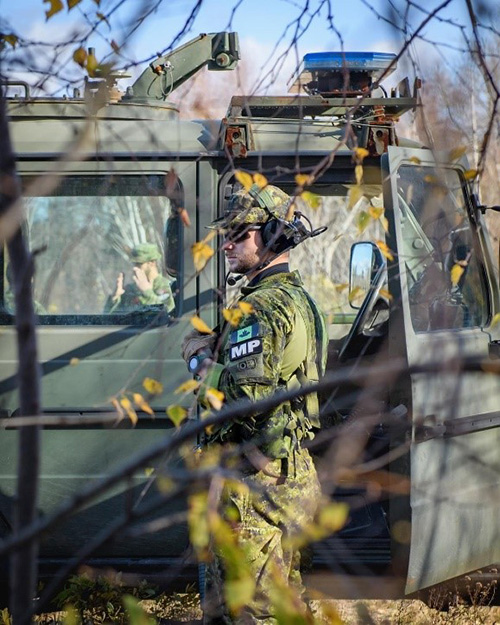
Caption
A member of the military police dressed in camouflage stands in a forest next to a military vehicle awaiting orders.
The office of Professional Standards (PS) for the CFPM was established in 1997. This team of nine military and civilian personnel report directly to the DCFPM. The mandate of PS is to carry out administrative investigations in respect of conduct that is inconsistent with PS applicable to MP or the MP Professional Code of Conduct (MPPCC) (“the Code”). In doing so, PS continues to enforce accountability for credentialed MP. As with any civilian police force, the conduct of MP personnel is critical to maintaining the trust of those they serve. Great efforts are being undertaken to resolve the backlog of complaints received from the public, and which meet the criteria of Part IV of the National Defence Act (NDA). PS also investigates allegations of a breach of “the Code” as required.
Management of the MP Credentials Review Board (MPCRB) process also resides in PS. The MPCRB is convened, upon requirement, to deliberate any MP conduct which allegedly breaches the MPPCC and is serious enough to question the suitability of that MP to maintain their MP credentials. If concerns of suitability of untrained MP arise, the MPCRB is also convened to deliberate and provide recommendations to the CFPM, and if warranted, also engages the MPCRB. The backlog of MPCRB resultant of COVID-19 have all been processed and MPCRB are convened three times a year upon requirement.
This year saw the commencement of a deliberate and comprehensive review of the processes and supporting directives associated with PS and the MPCRB. The results of this review and any recommendations are highly anticipated.
Military Police Analytics Program
Law enforcement agencies collect vast quantities of data in their response to incidents and the resulting search for answers through investigation. Data Management and Analytics (DMA) is focused on the organization and analysis of this information, in such a way that it can support evidence-based decision making at all levels of the institution. The main driver of analytics is the Military Police Analytics Program (MPAP), which provides support to the MP (internal dashboards and tools) and clients within the CAF, to the Department and to Government (external dashboards and sporadic reports). The two most important deliverables are the Departmental Results Report (DRR) and the Statistics Canada (StatCan) Uniform Crime Reporting (UCR) Survey.
Of particular importance to the CFPM is ensuring that the institution has the best data available about the people with whom MP interact, and how the general DND/CAF population feels about the quality of service offered by MP. Over the next several years, the MP with Defence Research and Development Canada and Director General Military Personnel Research and Analysis (DGMPRA) will develop and support the collection of this data. These initiatives will be used to establish the framework of public impression of MP services to improve outcomes and reinforce public accountability.
Military Police Legal Services
The Directorate of the Canadian Forces Provost Marshal Legal Advisor (CFPM LA) provides essential legal advice and support to the MP in their mission to provide professional policing, security, and detention services to the DND and CAF. CFPM LA is the principle legal advisor to the CF MP Gp HQ and the CFPM with the Director and two legal advisors located at the CF MP Gp HQ and the Office of the CFPM, and one legal advisor located at the CF Military Police Academy (CFMPA).
Throughout this reporting period, CFPM LA has demonstrated its ability to handle a wide range of legal issues arising from the variety of activities conducted by MP. Developments in the Military Justice System have caused MP to adapt their policies and training, requiring CFPM LA to be able to respond to the legal issues associated with these changes. As with last year, CFPM LA continues to play an important role in supporting MP policy development around the implementation of recommendations from the Third Independent Review of the National Defence Act, as well as from the Report of the Independent External Comprehensive Review (IECR). The coming into force of Bill C-77 has also meant increased challenges for the MP to adapt to changes in the Military Justice System with updated policies and training. CFPM LA has been pivotal in providing ongoing legal guidance to MP as they continue to navigate, these oftentimes complex processes. Moving forward, CFPM LA will also be focused on supporting MP as they prepare for the anticipated impact that the recently tabled Bill C-66, once passed, will have to their processes.
Again, this year, CFPM LA offered vital legal support to MP operations both domestically and globally. These operations spanned in scope from the day-to-day policing and security tasks carried out by MP at CAF bases and other facilities in Canada and around the world to specific contingency operations such as MP security support to CAF sentries at the National War Memorial. In operations, MP tend to perform complicated and highly sensitive tasks, where the reliance on timely, operationally focused legal advice is key to their success.
Furthermore, CFPM LA collaborated closely with counsel from the Office of the National Defence and Canadian Forces Legal Advisor (DND/CF LA) and the National Litigation Sector of the Department of Justice to support the CFPM in multiple litigation matters, ensuring that legal considerations for MP activities were well understood and supported in these proceedings.
CFPM LA also provided effective representation for the CF MP Gp during a court martial in relation to a third-party disclosure application and achieved a favourable outcome for their client. CFPM LA has continued to provide specialized and focused legal services to assist MP in carrying out their mission lawfully, considering the legally complex nature of their role.
Office of the Deputy Canadian Forces Provost Marshal
Support to the implementation of Recommendations from the Third Independent Review of the National Defence Act (Justice FISH Report).
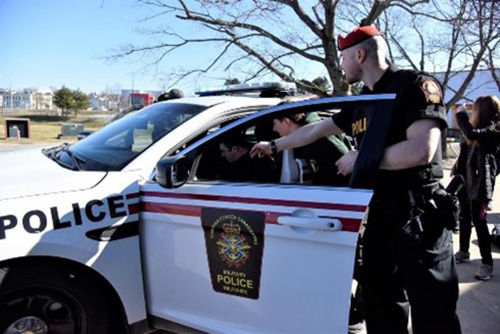
Caption
A member of the military police stands next to a military police cruiser during a community event that allows members of the public to sit in the police cruiser to turn on the sirens and lights.
To date the MP have successfully closed eight of the recommendations whereby the CFPM was noted as the OPI and continue to support the remaining 24 that have impact to the MP Program. Furthermore, three recommendations are currently before legislature as part of Bill C-66. Upon receiving royal assent this new legislation will advance the independence of the CFPM.
Implementation of the Interim Recommendation of Mme Arbour regarding the investigation of criminal code sexual offences taking place within the jurisdiction of the MP.
As of Dec 2021, the CFPM continues to implement the interim recommendation of Mme Arbour in that allegations of criminal code sexual offences occurring in Canada are referred to civilian police of concurrent jurisdiction in a victim-centric, trauma-informed approach. The final recommendation of Mme Arbour (recommendation 5) is also part of Bill C-66. Upon receiving royal assent this new legislation will address CAF jurisdiction over Criminal Code Sexual Offences.
Support to Civil Litigation
This past year has seen an increase in the number civil litigations whereby the MP have been involved in some capacity. The Office of the DCFPM works closely with the Office of the Department of National Defence and Canadian Forces Legal Advisor (DND/CF LA) to ensure that all disclosure and MP representations are provided during the course of these litigation processes.
Support to Ongoing Judicial Reviews
The Office of the DCFPM works closely with CF LA to address the three ongoing judicial reviews currently before the courts brought against the Attorney General by the Military Police Complaints Commission (MPCC). These judicial reviews look to address Part IV of the NDA and afford both the CFPM and the MPCC clarification as to the manner in which Part IV of the NDA is to be interpreted as it refers to the classification of conduct complaints and the legislative requirement for disclosure. In the interim the office of the DCFPM continues to work within the legislative framework afforded under Part IV of the NDA.
Highlights
Mp Provide Professional Policing and Security Services to Caf Operations
Op UNIFIER
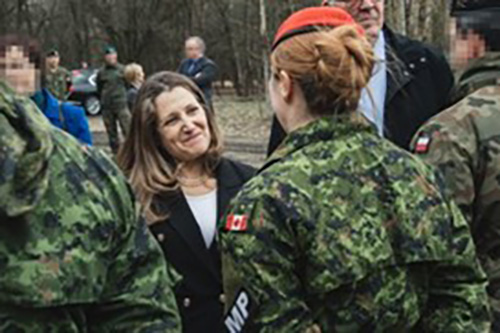
Caption
The Honourable Chrystia Freeland, Deputy Prime Minister and Minister of Finance is shown speaking to a member of the military police dressed in camouflage and red beret, deployed on Operation UNIFIER.
MP deployed in support of Op UNIFIER demonstrated their professionalism and knowledge when they worked alongside other nations law enforcements agencies, to ensure a safe and secure environment during the VIP commemoration visit in Ukraine.
Op REASSURANCE
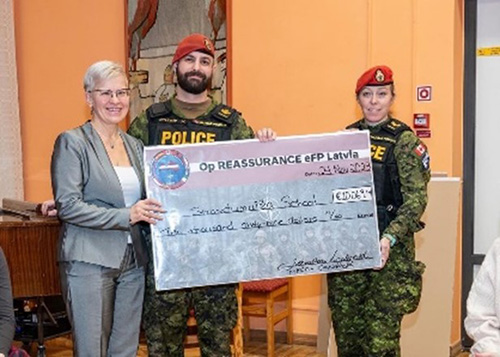
Caption
Members of the military police dressed in camouflage, red berets, and military police vests, deployed to Latvia as part of Operation REASSURANCE, present a large format cheque to the School for the Blind in Riga Latvia.
MP demonstrated their ever-lasting commitment to the communities in which they serve, even when overseas. During their deployment, MP held many charitable events in support of the Riga Strazdumuizas School for Blind Children and Children with Disabilities. The event fostered cohesion amongst partnered Nations and helped strengthen relations between Latvian people and Canada. During this rotation MP raised approximately €10,000.
Representation in the Community
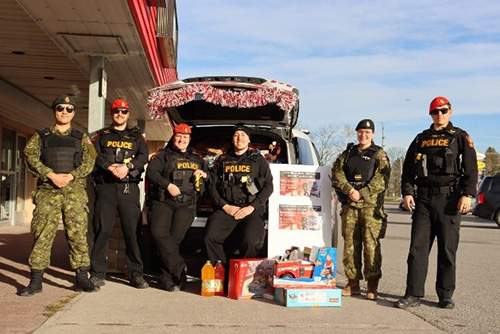
Caption
Members of the Military Police stand behind a police cruiser with donations of toys for their annual Fill-a-cruiser event for families in need during the holiday season.
MP participated in many community events and activities across Canada that helped raise money for charities.
MP hosted their annual Fill-a-Cruiser charity event, in Borden, Ontario, which helped many families in need during the holiday season by providing toys, cash, and food.
Canadian Police and Peace Officer Memorial Parade

Caption
Members of the Military Police stand in formation on Parliament Hill during the annual Canadian Police and Peace Officers Memorial, led by Brigadier General Simon Trudeau.
Members of the MP had the honour to participate in the 2023 Canadian Police and Peace Officer Memorial Parade on Parliament Hill.
Collaboration and Continued Learning
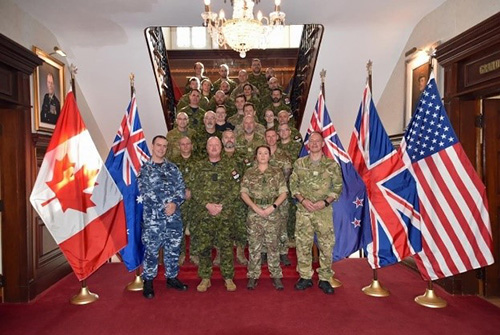
Caption
Members of the Military Police from across the nations of the Australia, New Zealand, Canada, the United Kingdom, and the United States of America gather for the first annual Provost Marshal Five Eyes Interoperability Conference at the Citadelle of Quebec, in Quebec City in 2023.
The CFPM had the honour to host the first Provost Marshal Five Eyes Interoperability Conference at the Citadelle of Quebec, in Quebec City. The aim of the conference was to develop MP capacity of participating countries, and to collaborate and learn from one another.
Aircraft Security Officer Course
MP worked tirelessly to create a new and improved Aircraft Security Officer Training Course. This course, now open to all trades in the Royal Canadian Air Force, touches on all aspects of Aircraft Security, from ground tactics to in-fight security procedures.
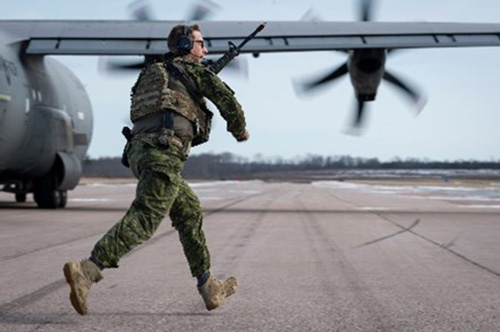
Caption
An Aircraft Security Officer runs across a tarmac behind a CC-130 Hercules during a training exercise, dressed in camouflauge with their carbine held in the air.
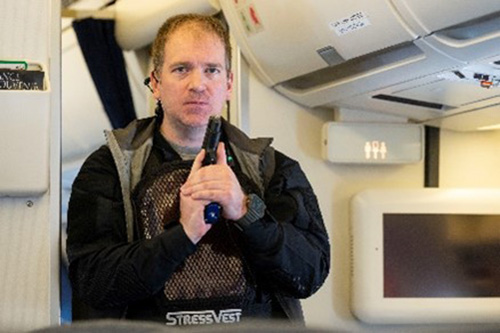
Caption
An Aircraft Security Officer, dressed in dark civilian clothing, presents their pistol in front of their body in the interior of an airplane during an Aircraft Security Officer exercise.
Mp Strive for the Highest Level of Proficiency by Participating in Exercises
Ex WATCHDOG EXPERT
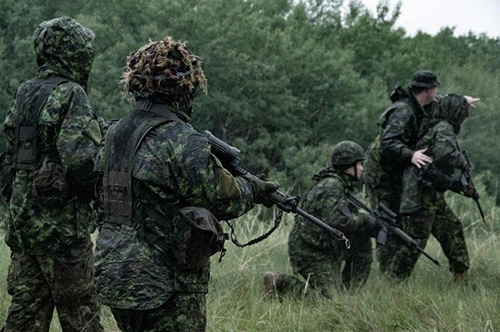
Caption
Members of the Reserve Force Military Police, dressed in camouflage and protective vest with carbine rifles, participate in Exercise WATCHDOG EXPERT, as part of the Basic Military Police Qualification.
During the summer, MP participated in Ex WATCHDOG EXPERT. This exercise served as the Reserve Force MP Gp members’ Basic Military Qualification. Throughout the course, MP received realistic and robust training touching on field and close support operations.
Ex MAPLE RESOLVE
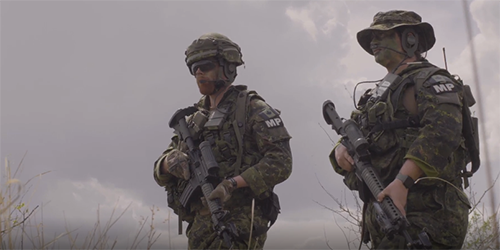
Caption
Members of the military dressed in camouflage with service rifles and radios, participate in Exercise MAPLE RESOLVE where they refined their practice with convoy escorts, traffic control points, and handling of captured persons and prisoners of war.
MP participated in Ex MAPLE RESOLVE. During the exercise, MP conducted convoy escorts, traffic control points, and practiced dealing with captured persons and prisoners of war. MP also practiced providing security and operational support to missions. This exercise was a great opportunity for MP to work alongside a variety of different Canada Armed Forces members and partner military personnel.
Military Police Strategic Plan 2019-2024
During the fiscal year 24/25, we will see the development of the next Strategic Plan 2025-2030. This plan will build on the success of the 2019-2024 Strategic Plan and will further enable the strengthening of MP credibility and reputation. The purpose of this plan is to outline the major initiatives that will be implemented to ensure a healthy and well-balanced MP force that can deliver an efficient and effective MP program within DND/CAF.
Update on the Five Main Priorities in the Strategic Plan
1. Domestic Policing and Force Structure
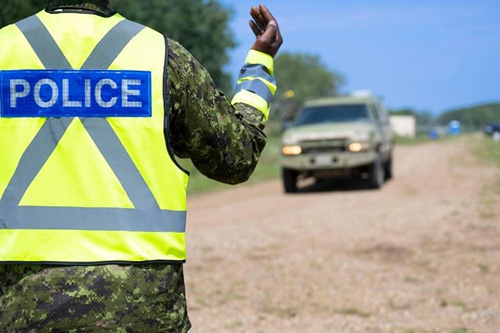
Caption
A member of the Military Police directs traffic in a yellow high-vis vest and camouflage with truck in the background of the image.
Throughout this past year, work continued to implement the Domestic Police Establishment Project (DPEP). Early in 2024, an updated DPEP implementation directive was distributed, and execution of the project began. Over the course of successive posting cycles, standardized detachment sizes will be implemented across Canada to provide the police support required by their respective Area of Responsibility.
In conjunction with the DPEP implementation directive distribution, the final Establishment Change Requests (ECR) were submitted for approval with an anticipated effective date of 1 April 2024. Realignment of personnel requirements is still anticipated to be gradual and will be executed over multiple active posting season (APS) until it has been achieved.
In parallel to DPEP implementation, a new initiative will begin to centralize the MP general investigative service capability under a single unified chain of command. This initiative aims to achieve a single investigative standard and improve overall investigative capability for the MP. Analysis has begun on structure, size, and investigative thresholds with the intent of beginning a pilot program in the fall of 2024.
2. Health and Wellness of the Force
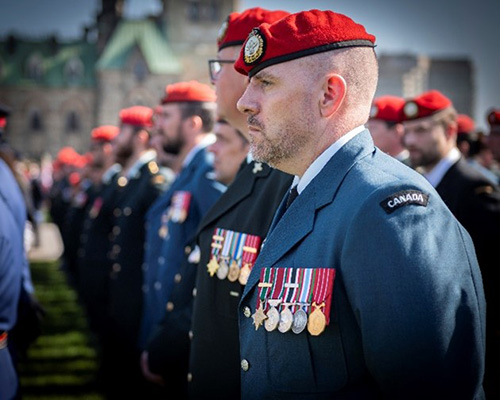
Caption
A member of the Military Police stands at ease in formation alongside other Military Police during a parade.
The CF MP Gp’s Health and Wellness Committee (H&WC) is accountable to the CFPM to monitor and report on the overall wellbeing of the MP Branch, while recommending and prioritizing tools that enable operational and tactical level commanders to promote a healthy workforce. To this end, “MP Balance,” an online resource providing MP patrol members fitness, nutrition, sleep, and mental health information and programs in both official languages, saw a gradual increase in site visits over the course of this year. The CF MP Gp also inculcated ninety-seven entry level members against work related stress through the Road to Mental Readiness for Military Police (R2MR4MP) program, while a further one-hundred-sixty-three leaders received training necessary to monitor the mental health of their subordinates through the same program.
Moving forward, the H&WC will further promote MP Balance to improve visits, and in partnership with Personnel Support Services, develop a mobile device app to make MP Balance information more readily available outside the Distance Learning Network 3.0. With the support of Canadian Forces Health Services, planning is also underway to adapt entry level R2MR4MP to make it amenable to annual refresher training.
3. Data Management and Analytics
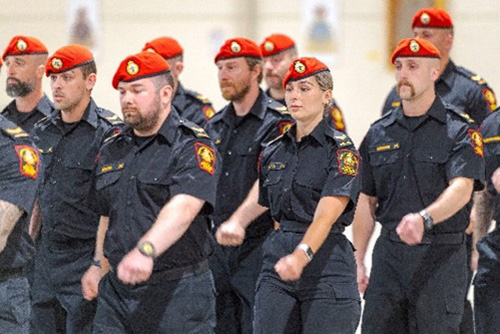
Caption
New Military Police graduates march as part of a group in their black operational patrol dress with red berets.
This year saw continued efforts by the MPAP to maintain the high standard of General Occurrence data to support performance reporting and decision making. Over the past year MPAP has pursued their relationship with Defence Research and Development Canada (DRDC) and focused their expertise, in three areas; multi-year analysis of computer-aided dispatch (CAD) data, research on population groups and intersectionality data collection and public impressions of the MP.
Of particular importance to the CFPM is ensuring that the institution has the best data available about the people with whom MP interact, and how the general DND/CAF population feels about the quality of service offered by MP. Over the the next several years, the MP with DRDC and Director General Military Personnel Research and Analysis (DGMPRA) will develop and support the collection of this data. These initiatives will be used to establish the framework of public impression of MP services to improve outcomes and reinforce public accountability.
The MPAP also continues to provide ad hoc reporting in support of various departmental initiatives, and is developing standardized external dashboards to inform supported commanders at all levels on criminal trends, community policing initiatives and policing matters impacting military activities.
4. MP Reserve Optimization
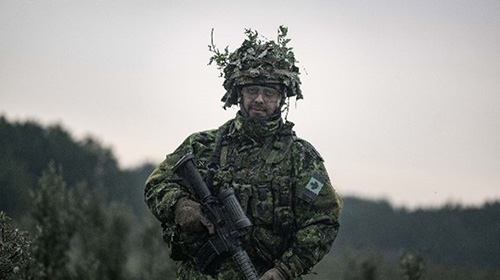
Caption
A member of the military police is shown in a forest setting with vegetation in their helmet cover as part of their camouflage in a field setting.
The MP Reserve is comprised of four close support MP Companies (11 Reserve MP Platoons located in Canada’s major urban centers) under the command of the four MP Regiments that comprise the Army Military Police Group, and one general support MP Company under command of CF MP Gp HQ.
Over the last decade, it has become apparent that the Reserve MP training model and an inconsistent assignment of mission and tasks have led to reduced operational output. Concurrent to this realization, the CF MP Gp has had to react to the CAF’s strategic initiatives of Force Mix Structural Design (FMSD), and most importantly the Strong, Secure, Engaged (SSE) Defence policy by way of implementing a plan focused on the integration of the MP Reserve Force. This led to the development of Op UNITY.
The CF MP Gp is entering the fourth year of Op UNITY, a nine-year undertaking to leverage the MP Reserves for the purpose of institutionalizing a permanent Close Support MP capability across the full spectrum of MP operations, both domestically and abroad. This undertaking will address a significant transformation of the individual training that Reserve MP receive in addition to a deliberate focused approach to assessing, measuring, and validating collective close support MP capability. It will have a transformative effect upon how the CF MP Gp trains for the purpose of executing its non-law enforcement tasks for the CAF’s supported commanders. Op UNITY has been extended beyond its original six-year scope to align with Departmental initiatives.
The future of the MP Reserve will be completely in line with the CDS strategic intent in that the CF MP Gp will ensure it is fully capable of providing “full time capability through part-time service”. These future capabilities are starting to be realized with the investiture of close operations into the Primary Reserve, making them the subject matter experts for these essential component of CAF operations.
5. Modernization of MP Equipment and Technology Through Force Development
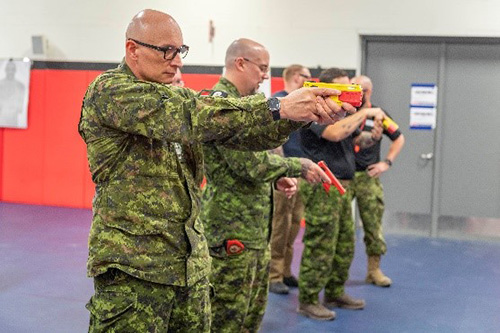
Caption
Members of the Military Police are shown in a line, dressed in camouflage, trialing the new Taser 10 from Axion.
The CF MP Gp continued to hone its capacity to identify and implement necessary changes to existing capabilities while also developing new capabilities through Force Development (FD). Investment in personnel trained as Army Technical Staff Officers and Warrant Officers, in concert with strategic-level governance through the Capability Development Committee, ensured that FD was an integral part of the CF MP Gp business planning and operational planning cycles balancing MP needs with resource allocation.
While FD is concerned with all aspects of capability development including doctrine and training, MP equipment needs are divided into four major categories:
- Soldier Systems – all kits carried by the MP, from the uniforms they wear, to their Use of Force (UoF) accoutrements;
- Mobility – refers to transport and other vehicle-borne systems;
- Command, Control, Communications, Computers (C4) – includes all systems related to enhancing situational awareness and command and control through tactical communications, and the management of information and other digital assets; and
- Infrastructure – comprises the static buildings, facilities and other permanent installations required to support MP capabilities.
I. Soldier Systems
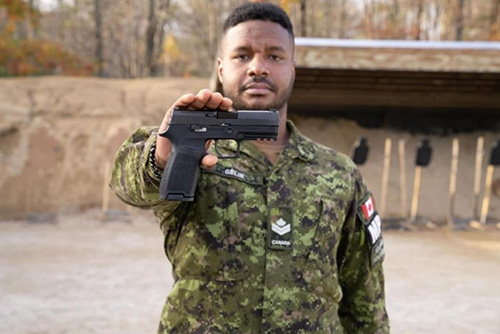
Caption
A member of the Military Police dressed in camouflage holds the new C24 Military Police Service Pistol at the Sig Sauer factory in Newington, NH, USA, on 25 October 2023.
The CF MP Gp, both Reg F and Res F, will be equipped with the C24 variant (carry and compact frame) of the Sig Sauer P320 platform in FY 2024/25. The focus of this pistol is modularity. This is to ensure the performance of the pistol over the full spectrum of MP Ops while meeting the requirements of the individual user.
At present, the project is in the implementation phase, with Use of Force Instructors having undergone specialized training at the Sig Sauer Academy and Experience Center in New Hampshire. This training was aimed to modernize the MP shooting package while facilitating the delivery of a Train the Trainer program. Requirements were identified down to the unit level with delivery of the equipment scheduled for early 2024. As conversion training is completed, units will be supported in immediately rolling over to the new platform upon declaring operational readiness.
Next Generation MP Operational Dress (NGMPOD) – NGMPOD will be a MP-specific variant of the Canadian Combat Uniform Ensemble (CCUE) and will be tailored to fit our unique policing needs from a task perspective including MP identifiers. Moving to this style of uniform will permit a common look and feel for all MP employment situations while also enhancing MP recognition and identity throughout the CAF. CCUE is currently in a trial phase led by Directorate Land Requirements – CF MP Gp is permitted to conduct a sub-trial simultaneously.
Between January to June 2024, 5x MP members (2x MP Fld Pl NCM, 2x MP Det NCM and 1x MPO) will trial the uniform. These members will evaluate the uniform through their daily pattern of life in their respective roles. The members will also be leveraging any training opportunities provided by the Fld Pl, CFMPA and ASO Flights to provide further feedback. Additional prototyping and verification will be necessary prior to purchasing the textiles required to outfit the CF MP Gp. Implementation is expected in FY 2026/2027 pending the feedback from the trials.
Enhanced Soft Body Armour (ESBA) – An Unsatisfactory Conditions Report (UCR) identified a compatibility issue between select NATO Stock Numbers (NSNs) of ESBA against CAF standard sizes of ballistic plates. FD and the Director Soldier Systems Project Management (DSSPM) conducted a human factors assessment while determining a fabrication solution in consult with Defence Research and Development Canada. The availability of extra small ballistic plates for the impacted MP was increased to include all impacted members. This project was turned over to CF MP GP HQ for continued in-service support throughout the life of the capability. FD is monitoring evolutions in ballistic plates; specifically, inclusive Personal Protective Equipment (PPE) initiatives of the Canadian Army. DSSPM 5 is leading a phased initiative to improve PPE to be better suited to accommodate a variety of body types.
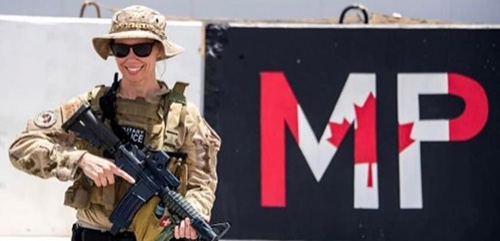
Caption
A member of the Military Police, dressed in Canadian Arid Pattern uniform stands in front of a large black, white and red with the letters M and P with their carbine held in front of them.
Next Generation Conducted Energy Weapons (CEW) – CF MP Gp has successfully implemented CEW into domestic policing operations. The Axon X2 platform was announced to be discontinued. Simultaneously, the recommended shelf-life for this capability is 5-years from its initial implementation date in 2021/2022. Axon is conducting a demonstration of their product line in support of determining the next evolution of CEW within the CF MP Gp. This will ensure that MP continue to maintain a non-lethal means to subdue combative subjects providing greater flexibility in use of force options.
Frangible Training Ammunition (FTA) – Designed to disintegrate upon striking metal plate targets, FTA is an ideal choice for indoor ranges and close-quarter battle training. Its lead-free composition not only reduces toxicity to users but also diminishes the risks associated with overpenetration and ricochet-induced injuries. The newly developed MP shooting package will benefit from both 9mm and 5.56mm frangible ammunition, aligning with the ongoing efforts to modernize equipment and training. Through collaboration with specialist stakeholders within the CF MP Gp, the FD team is in the process of developing a Statement of Requirement for FTA, expected to be finalized no later than FY 2024/2025.
FBI Protocol Certified 9mm Jacketed Hollow-Point (JHP) Ammunition – Procuring the next shipment of 9mm JHP ammunition is imperative to guarantee an ample supply for fulfilling domestic policing duties. The FD section has submitted a Statement of Requirement to Director Ammunition and Explosive Management and Engineering, emphasizing the criteria for modern 9mm JHP rounds. Extensive research conducted by the FBI on wound ballistics and ammunition effectiveness has culminated in what is now known as "The FBI Protocol," setting the benchmark for law enforcement ammunition standards. Adhering to these standards will minimize collateral damage while optimizing ballistic performance in law enforcement applications.
II. Mobility

Caption
An Aircraft Security Officer stands sentry with their carbine, in front of a grey CC-130 Hercules airplane with the word Canada on the fuselage.
Vehicle Outfitting - During the 23-24 FY, the transport section upfitted twenty-eight patrol and unmarked vehicles for both MP Detachments and the CFNIS. These vehicles were sent to the MP Detachments allowing for the Vehicle Off Road (VOR) rate of the CF MP Gp to be reduced and increase MP Detachments vehicle capability in conjunction with the MP Mandate. During the fiscal year, ten patrol vehicles had all the policing kit removed and were life cycled out of the MP Group. Lastly, this past year, MP conducted a Staff Assistance Visit (SAV) to 1 MP Dets in Atlantic Canada. During such time, MP had the opportunity to provide information and ensure all Dets were adhering to the CAF Transport Policy.
III. Command, Control, Communications, Computers (C4)
Digital Information Strategy – The CF MP Gp will conduct a thorough options analysis to bridge the gap from the current state to what is needed to achieve the end state of the CFPM’s digital information vision. Areas that may be explored to enhance readiness include: consolidation of Public Safety Answering Points (PSAP); meeting the new challenges of digital evidence management and interview capabilities (Securely collect, manage, search, and share digital evidence with Law Enforcement & Security partners); digitizing the tools available to frontline MP (allowing powerful and intuitive search capabilities to find information more quickly); and enabling access to MP systems of record by Defence partners to make data-driven and evidence-based decisions.
Next Generation 911 (NG911) – Following Canadian Radio-Television and Telecommunications Commission direction that emergency dispatch transition to internet protocol based systems by March 2025, the CF MP Gp has worked with stakeholders such as the Assistant Deputy Minister for Infrastructure and Environment (ADM(IE)), the Strategic Joint Staff (SJS) and the Canadian Forces Fire Marshal (CFFM), to assess the requirements to equip our detachments with the hardware and software necessary to accept the transfer of digital information from primary PSAP.
Simultaneously, the CF MP Gp worked with specific stakeholders to enable our Security and Military Police Information System (SAMPIS) - Computer-Aided Dispatch (CAD) to physically connect to the new NG911. This will enable the communication of text, photos, videos, and GPS location in addition to voice to first responders. This will improve MP situational awareness and allow MP to proactively manage data in real-time to support deployment decisions and response times whilst creating redundancy during a time of crisis.
IV. Infrastructure
Nothing significant to report.
Training Update
This year was a challenging yet rewarding year in terms of MP Individual Training & Education (IT&E). Led by the Canadian Forces Military Police Academy (CFMPA) and the Assistant Chief of Staff for Readiness (ACOS Rdns) teams, the CF MP Gp attained near preCOVID-19 levels of IT&E, continued to realign training outcomes through the Military Employment Structure Implementation Plan (MESIP), and increasingly leveraged technology to modernize MP IT&E. CFMPA and ACOS Rdns staff also contributed to implementation of the C24 Military Police Pistol capability.
Training by Numbers. CFMPA saw an increase in student throughput from the previous year through an innovative blend of in-house, distance learning and decentralized MP IT&E. The numbers along CFMPA’s four (4) Lines of Effort (LoE) are below, totaling fourhundred-ninety-three (493) students that graduated:
- LoE Development Phase 1 (Qualification Level 3 (QL3)/Military Police Officer Course) – 97;
- LoE Advanced Training (QL5/Primary Reserve (PRes) QL5/Use of Force Instructor/Military Police Investigator Course) – 163;
- LoE Distance Learning (QL6A/PRes QL6A/QL6B) – 102; and
- LoE Decentralized Training (Soldier Qualification/ PRes QL3/Close Protection Operator Course/MP Surveillance Course) – 131.
Military Employment Structure Implementation Plan (MESIP). Driven by the mandated review of MP and MPO Master Task List requirements, CFMPA and ACOS Rdns staff continued to work through MESIP updates and amendments for each of the CF MP Gp’s Qualification Standards and Training Plans (QSP). 2023-24 saw the first updated course come to fruition with the Rank Qualification Private MP Junior Patroller Course (RQ Pte/ MPJPC, formally known as Qualification Level 3) in January 2024. Reflecting realigned training objectives that include trauma informed and victim-centric approaches to policing, RQ Pte/MPJPC graduates will be better postured to meet the evolving needs of our Defence community. The QSP for Rank Qualification Corporal that will replace Qualification Level 5 was also approved in 2023-24, paving the way for Main Lesson Plan development over the course of the next year. Other QSPs to be revisited in the near future in order of priority include the Use of Forces Instructor Course, Pres RQ Pte/Close Support Course, and Pres RQ Cpl.
MP Virtual Academy. Acting as the sole digital repository for all course control and training documentation and materials for each of the CF MP Gp’s career and specialist courses, the MP Virtual Academy went “live” this year on the Defence Wide Area Network. Enabling CFMPA to better control and update MP IT&E related information to reflect new case law and emerging law enforcement best practices, the Virtual Academy will also allow graduates to review course materials commensurate with their level of training and career progression. CF MP Gp units in turn, are also afforded access to the same materials taught at CFMPA to lead their own remedial or refresher training at their convenience. Replete with a feedback mechanism from end-users to report out-ofdate information, the Virtual Academy will continue to evolve to meet the needs of the CF MP Gp’s membership. Other initiatives to modernize MP IT&E through information technology this year included uploading the Academy Staff Indoctrination package onto the Distance Learning Network 3.0 and the introduction of online testing across the CF MP Gp’s suite of courses, also on the Distance Learning Network 3.0.
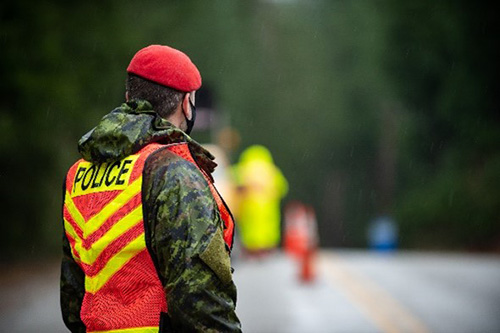
Caption
"A member of the Military Police, dressed in their red beret and camouflage uniform and a high-vis orange and yellow vest, stands sentry at a vehicle traffic stop along a highway.
Annex A – Incident Statistics
The data contained in this report is based on the data available on 25 April 2024 within the Security and MP Information System (SAMPIS). As investigations continue to mature, this data will be updated to reflect new information and outcomes. Consequently, minor variations are to be expected when comparing numbers over time, in particular concerning investigations opened towards the end of 2023.
Unless otherwise stated, the numbers and analysis presented includes only General Occurrence (GOs) reports in which MP were the sole or lead investigative agency. These figures exclude joint investigations where another agency is lead, or shadow files. Shadow files are MP incident reports documenting when CAF members are arrested by civilian police and the matter is brought to the attention of MP. Shadow file reports are generated to inform the CAF chain of command of incidents involving their members.
With a victim centric approach of supporting the referral of criminal code sexual offences to the civilian police of concurrent jurisdiction (since December 2021), there is a noticeable drop in the number of violent crimes.
This data provides details on the number of reported incidents, the number of founded incidents and the number of cleared incidents. Definitions for each of these categories are contained at the end of the annex. Although an incident may be cleared by charges, the data does not include the outcomes of the judicial processes.
The data provided reports on incidents by year of report, and expresses the length of investigations by the minimum, maximum, median (middle) and mean (average). These figures should be compared longitudinally (over time) and viewed in conjunction with the number of calls for service, the number of founded investigations, and any available human resource data, to understand variation over time. It is not possible to compare a single investigation to these figures, as no two investigations are identical, and each is liable to have unique investigative steps. Finally, no police agency has been identified as sharing this data. As a result, no comparisons or inferences can be drawn.
| Categories | 2019 | 2020 | 2021 | 2022 | Interim 2023 |
|
|---|---|---|---|---|---|---|
| Report Types | ||||||
| Calls for ServiceFootnote 1 | 36643 | 30686 | 36262 | 38103 | 39796 | |
| Field InquiriesFootnote 2 | 40714 | 37792 | 35589 | 33928 | 32052 | |
| TicketsFootnote 3 | 2655 | 1552 | 1713 | 1474 | 1561 | |
| Crimes Against the Person (Violent Offences) | ||||||
| Founded | 526 | 323 | 439 | 388 | 430 | |
| Cleared | 275 | 187 | 246 | 225 | 214 | |
| Weighted Clearance Rate | 46.8 | 52.7 | 55.9 | 56.6 | 39.6 | |
| Crimes Against Property | ||||||
| Founded | 609 | 461 | 486 | 556 | 580 | |
| Cleared | 89 | 54 | 45 | 52 | 68 | |
| Weighted Clearance Rate | 19 | 16.6 | 11.9 | 10.4 | 14.3 | |
| Other Criminal Code Violations | ||||||
| Founded | 147 | 135 | 126 | 85 | 119 | |
| Cleared | 95 | 112 | 79 | 59 | 57 | |
| Weighted Clearance Rate | 46.7 | 74.6 | 58.6 | 63.9 | 40.7 | |
| Drug Violations | ||||||
| Founded | 54 | 28 | 34 | 27 | 24 | |
| Cleared | 23 | 10 | 13 | 9 | 12 | |
| Weighted Clearance Rate | 35.3 | 37 | 33.6 | 15.5 | 37.7 | |
| National Defence Act | ||||||
| Founded | 362 | 479 | 527 | 340 | 222 | |
| Cleared | 286 | 354 | 327 | 191 | 76 | |
| Weighted Clearance Rate | 79.8 | 74.5 | 62 | 56.1 | 33.2 | |
| Other Federal Statutes | ||||||
| Founded | 37 | 17 | 11 | 2 | 19 | |
| Cleared | 25 | 9 | 1 | 0 | 11 | |
| Weighted Clearance Rate | 73.8 | 63.7 | 2.4 | 0 | 65.6 | |
| Criminal Traffic Violations | ||||||
| Founded | 72 | 83 | 102 | 109 | 132 | |
| Cleared | 57 | 59 | 80 | 90 | 96 | |
| Weighted Clearance Rate | 65.2 | 48.9 | 64.5 | 64.6 | 54.1 | |
| Total Non-Violent Offences | ||||||
| Founded | 1281 | 1203 | 1286 | 1119 | 1096 | |
| Cleared | 575 | 598 | 545 | 401 | 320 | |
| Weighted Clearance | 47.4 | 52.3 | 64.5 | 64.6 | 54.1 | |
| Grand Total | ||||||
| Founded | 1807 | 1526 | 1725 | 1507 | 1526 | |
| Cleared | 850 | 785 | 791 | 627 | 534 | |
| Weighted Clearance | 47.1 | 52.4 | 49 | 41.4 | 32.3 | |
| Final 2022 | Interim 2023 | ||||||||
|---|---|---|---|---|---|---|---|---|---|
| Rep.Footnote * | Fnd.Footnote ** | Weight ClearFootnote *** | Rep. | Fnd. | Weight Clear | ||||
| Categories | # | # | /100 | # | Δ | # | Δ | /100 | ΔFootnote 1 |
| Crimes Against the Person | 419 | 388 | 56.6 | 469 | 50 | 430 | 42 | 39.6 | (17.1) |
| Violations Causing Death | 0 | 0 | - | 1 | 1 | 1 | 1 | 0.0 | 0.0 |
| Attempt Capital Crime | 1 | 1 | 100 | 1 | 0 | 1 | 0 | 100 | 0.0 |
| Sexual Assault | 89 | 82 | 50.5 | 108 | 19 | 107 | 25 | 41.4 | (9.1) |
| Sexual Crimes Against Children | 10 | 8 | 61.7 | 13 | 3 | 10 | 2 | 51.1 | (10.6) |
| Other Sexual Crimes | 8 | 7 | 23.8 | 9 | 1 | 8 | 1 | 58.7 | 34.9 |
| Historical Sexual Crimes | 3 | 3 | 100 | 2 | (1) | 2 | (1) | 100.0 | 0 |
| Assaults & Firearms Offences | 166 | 157 | 84.2 | 166 | 0 | 156 | (1) | 62 | (22.2) |
| Violations Deprivation of Freedom | 3 | 3 | 100 | 5 | 2 | 2 | (1) | 44.8 | (55.2) |
| Robbery & Other Violence | 137 | 125 | 31.8 | 162 | 25 | 141 | 16 | 24.7 | (7.1) |
| Commodification of Sexual Activity | 2 | 2 | 0.0 | 2 | 0 | 2 | 0 | 50 | 50.0 |
| Crimes Against Property | 598 | 556 | 10.4 | 632 | 34 | 579 | 23 | 14.3 | 3.8 |
| Arson | 3 | 3 | 66.7 | 8 | 5 | 7 | 4 | 0 | (66.7) |
| Break and Enter | 86 | 85 | 9.4 | 84 | -2 | 77 | -8 | 17.9 | 8.5 |
| Theft Over $5000 | 47 | 42 | 7.2 | 32 | -15 | 26 | -16 | 8.8 | 1.6 |
| Theft Under $5000 | 260 | 243 | 4.5 | 275 | 15 | 257 | 14 | 6.9 | 2.4 |
| Possess or Traffic Property | 7 | 7 | 42.8 | 9 | 2 | 8 | 1 | 40.5 | (2.4) |
| Fraud | 51 | 43 | 16.6 | 62 | 11 | 53 | 10 | 20.9 | 4.2 |
| Mischief | 144 | 133 | 12.3 | 162 | 18 | 151 | 18 | 11.7 | (0.6) |
| Other Criminal Code Violations | 104 | 85 | 63.9 | 129 | 25 | 119 | 34 | 40.7 | (23.2) |
| Group 1 | 76 | 68 | 83 | 88 | 12 | 82 | 14 | 45.6 | (37.4) |
| Group 2 | 24 | 14 | 12.3 | 31 | 7 | 27 | 13 | 27.1 | 14.8 |
| Weapons Offences | 4 | 3 | 100 | 9 | 5 | 9 | 6 | 45.9 | (54.1) |
| Public Morals | - | - | - | 1 | 1 | 1 | 1 | 0 | 0 |
| Drug Violations | 27 | 27 | 15.5 | 26 | (1) | 24 | (3) | 37.7 | 22.2 |
| CDSA | 24 | 24 | 12.8 | 20 | (4) | 19 | (5) | 35.6 | 22.8 |
| Cannabis Act | 3 | 3 | 72.7 | 6 | 3 | 5 | 2 | 56 | (16.7) |
| National Defence Act | 366 | 340 | 56.1 | 241 | (125) | 222 | (118) | 33.2 | (22.9) |
| Service Offence | 357 | 332 | 55.9 | 241 | (116) | 222 | (110) | 33.2 | (22.8) |
| Civil Offence | 9 | 8 | 62.5 | - | (9) | - | (8) | - | (62.5) |
| Other Federal Statutes | 2 | 2 | 0 | 24 | 22 | 19 | 17 | 65.6 | 65.6 |
| Criminal Traffic Violations | 115 | 109 | 64.6 | 136 | 21 | 132 | 23 | 54.1 | (10.5) |
| Dangerous Operation | 3 | 3 | 66.7 | 7 | 4 | 7 | 4 | 57 | (9.6) |
| Impaired Operation | 93 | 88 | 91.8 | 99 | 6 | 96 | 8 | 83.9 | (8) |
| Flight | 3 | 3 | 66.7 | 8 | 5 | 8 | 5 | 50 | (16.7) |
| Other Traffic Violations | 16 | 15 | 26.5 | 22 | 6 | 21 | 6 | 23.7 | (2.8) |
| Provincial Offences | 224 | 223 | 95.9 | 272 | 48 | 269 | 46 | 93.6 | (2.3) |
| Government Property Traffic Act | 122 | 122 | 95.9 | 140 | 18 | 140 | 18 | 93.6 | (2.3) |
| Provincial Traffic | 90 | 90 | - | 122 | 32 | 120 | 30 | - | - |
| Provincial Statutes | 11 | 10 | - | 9 | (2) | 9 | (1) | - | - |
| Municipal Bylaw | 1 | 1 | - | - | (1) | - | (1) | - | - |
| Non-Criminal Events | 1787 | 1769 | 1762 | (25) | 1741 | (28) | - | - | |
| Accident/Injury | 85 | 84 | - | 72 | (13) | 72 | (12) | - | - |
| Vehicle Accident | 558 | 556 | - | 574 | 16 | 573 | 17 | - | - |
| Property Damage | 412 | 407 | - | 351 | (61) | 346 | (61) | - | - |
| Persons in Crisis | 665 | 659 | - | 670 | 5 | 660 | 1 | - | - |
| Death Investigation | 18 | 17 | - | 17 | (1) | 15 | (2) | - | - |
| Family Discord | 44 | 41 | - | 53 | 9 | 50 | 9 | - | - |
| Civil Dispute | 4 | 4 | - | 19 | 15 | 19 | 15 | - | - |
| Miscellaneous | 1 | 1 | - | 6 | 5 | 6 | 5 | - | - |
| Discipline | 164 | 150 | - | 247 | 83 | 224 | 74 | - | - |
| Service Infraction | 62 | 60 | - | 128 | 66 | 125 | 65 | - | - |
| Alcohol Misconduct | 2 | 2 | - | 1 | (1) | 1 | (1) | - | - |
| Professional Misconduct | 96 | 84 | - | 115 | 19 | 95 | 11 | - | - |
| Weapons | 4 | 4 | - | 3 | (1) | 3 | (1) | - | - |
| Police Support | 137 | 133 | - | 174 | 37 | 167 | 34 | - | - |
| Assistance to Civilian Police | 48 | 47 | - | 71 | 23 | 68 | 21 | - | - |
| Animal Control | 26 | 26 | - | 27 | 1 | 27 | 1 | - | - |
| Other | 63 | 60 | - | 76 | 13 | 72 | 12 | - | - |
| Security | 3176 | 3138 | - | 3442 | 266 | 3399 | 261 | - | - |
| Departmental Security Program | 3010 | 2976 | - | 3243 | 233 | 3204 | 228 | - | - |
| Lost and Found | 166 | 162 | - | 199 | 33 | 195 | 33 | - | - |
| Other Reports | 89 | 86 | - | 58 | (31) | 56 | (30) | - | - |
| Administration | 43 | 40 | - | 20 | (23) | 19 | (21) | - | - |
| Criminal Intelligence | 46 | 46 | - | 38 | (8) | 37 | (9) | - | - |
| Grand Total General Occurrences | 7208 | 7006 | 42.8 | 7612 | 404 | 7381 | 375 | 34 | -8.8 |
| 2022 | 2023 | |||||
|---|---|---|---|---|---|---|
| Category | Reported | Cleared | Weighted Clearance | Reported | Cleared | Weighted Clearance |
| Crimes Against the Person | 419 | 226 | 56.6% | 469 | 214 | 39.6% |
| Crimes Against Property | 598 | 52 | 10.4 | 632 | 68 | 14.3 |
| Other Criminal Code Violations | 104 | 59 | 63.9% | 129 | 57 | 40.7% |
| Drug Violations | 27 | 9 | 15.5% | 26 | 12 | 37.7% |
| National Defence Act | 366 | 191 | 56.1% | 241 | 76 | 33.2% |
| Other Federal Statutes | 2 | 0 | 0% | 24 | 11 | 65.6% |
| Total Excluding Traffic | 1516 | 537 | 40.9% | 1521 | 438 | 31.6% |
| Criminal Traffic Violations | 115 | 90 | 64.6% | 136 | 96 | 54.1% |
| Files Cleared | ||||||||||||
|---|---|---|---|---|---|---|---|---|---|---|---|---|
| Charged/Charges Recommended | Cleared Otherwise | |||||||||||
| Length of Investigation (Days) | Length of Investigation (Days) | |||||||||||
| Year | Type | # Files | Min | Max | Median | Mean | # Files | Min | Max | Median | Mean | |
| 2019 | SAFootnote 1 | 53 | 0 | 741 | 171 | 215 | 30 | 0 | 722 | 7 | 62 | |
| SCFootnote 2 | 6 | 4 | 589 | 45 | 129 | 2 | *Footnote * | * | * | * | ||
| OTFootnote 3 | 3 | * | * | * | * | 2 | * | * | * | * | ||
| HIFootnote 4 | 1 | * | * | * | * | 0 | - | - | - | - | ||
| Total | 63 | 0 | 1556 | 169 | 224 | 34 | 0 | 722 | 6 | 69 | ||
| 2020 | SA | 44 | 0 | 831 | 212 | 237.1 | 7 | 0 | 241 | 171 | 144.4 | |
| SC | 4 | * | * | * | * | 1 | * | * | * | * | ||
| OT | 0 | - | - | - | - | - | - | - | - | - | ||
| HI | 0 | - | - | - | - | 1 | * | * | * | * | ||
| Total | 48 | 0 | 831 | 197 | 223 | 9 | 0 | 241 | 110 | 126.6 | ||
| 2021 | SA | 81 | 0 | 856 | 225 | 255.2 | 17 | 5 | 499 | 87 | 154.1 | |
| SC | 4 | * | * | * | * | 1 | * | * | * | * | ||
| OT | 1 | * | * | * | * | 0 | - | - | - | - | ||
| HI | 3 | * | * | * | * | 4 | * | * | * | * | ||
| Total | 89 | 0 | 856 | 214 | 252.5 | 22 | 5 | 499 | 118 | 158.4 | ||
| 2022 | SA | 28 | 0 | 635 | 125 | 187.5 | 13 | 5 | 461 | 56 | 102.8 | |
| SC | 4 | * | * | * | * | 1 | * | * | * | * | ||
| OT | 2 | * | * | * | * | 0 | - | - | - | - | ||
| HI | 0 | - | - | - | - | 3 | * | * | * | * | ||
| Total | 34 | 0 | 635 | 118.5 | 180.3 | 17 | 0 | 461 | 60 | 112.1 | ||
| 2023 | SA | 29 | 0 | 167 | 20 | 40.9 | 16 | 0 | 224 | 72.5 | 84.6 | |
| SC | 3 | * | * | * | * | 2 | * | * | * | * | ||
| OT | 2 | * | * | * | * | 3 | * | * | * | * | ||
| HI | 1 | * | * | * | * | 1 | * | * | * | * | ||
| Total | 35 | 0 | 338 | 31 | 64.7 | 22 | 0 | 224 | 52.5 | 75 | ||
| 2019-2023 Combined | SA | 235 | 0 | 856 | 169.5 | 208 | 83 | 0 | 722 | 42 | 98.7 | |
| SC | 21 | 1 | 589 | 21 | 124.5 | 7 | 2 | 459 | 48 | 124.9 | ||
| OT | 8 | 0 | 385 | 138 | 148.5 | 5 | * | * | * | * | ||
| HI | 5 | * | * | * | * | 9 | 16 | 373 | 114 | 146 | ||
| Total | 269 | 0 | 1556 | 167 | 207 | 104 | 0 | 722 | 51 | 101 | ||
| Year | Incident Type | Founded | SMRC Flag | RMC Flag | Cadet Flag | Drugs/Alcohol Involved | Family Violence |
|---|---|---|---|---|---|---|---|
| 2022 | Historical Sexual Violations | 3 | 0 | 0 | 0 | 2 | 0 |
| Sexual Assault | 82 | 10 | 19 | 17 | 64 | 24 | |
| Sexual Violations Against Children | 8 | 0 | 2 | 4 | 2 | 2 | |
| Other Sexual Violations | 7 | 0 | 2 | 2 | 0 | 1 | |
| Subtotal | 100 | 10 | 23 | 23 | 68 | 27 | |
| 2023 | Historical Sexual Violations | 2 | 0 | 0 | 0 | 1 | 0 |
| Sexual Assault | 107 | 17 | 12 | 14 | 62 | 26 | |
| Sexual Violations Against Children | 10 | 1 | 0 | 4 | 0 | 6 | |
| Other Sexual Violations | 8 | 0 | 1 | 0 | 1 | 1 | |
| Subtotal | 127 | 18 | 13 | 18 | 64 | 27 | |
| Total | 227 | 28 | 36 | 41 | 132 | 60 | |
Note 1: This table list reports of specific incidents generated over the designated year which were identified as founded but may still be ongoing, cleared by charges or charges recommended, or cleared otherwise.
Note 2: An investigation may involve one or more of the above flags, and the total number of incidents may be less than the sum of each individual flag.
Definitions
- Calls for Service
- Incidents reported to the Military Police, by telephone or in person reporting to a Military Police Unit, Detachment or CFNIS Regional Office.
- Charged/Subject Chargeable (CSC)
- A subject who has been charged, or where police have sufficient grounds to lay a charge against the identified individual in connection with the reported incident.
- Cleared
- An incident is considered cleared when a CSC has been identified in connection with the incident. Files may be cleared by charge, or cleared otherwise.
- Cleared by Charge
- An incident is cleared by charge when police lay a charge, or in cases where police recommend charges in provinces or situations where Crown charge approval is required (e.g., BC, QC, NB).
- Cleared Otherwise
- An incident is cleared otherwise when police have sufficient grounds to charge a CSC in connection with the incident, however police do not lay a charge. Reasons may be discretionary (e.g., diversion), or they may be outside police control (e.g., death of accused).
- Field Inquiry
A field inquiry refers to field inquiries made by police, formerly reported as “street checks.” Though the records management system still refers to them as street checks, the terminology will be updated in future versions as the term “street check” has become synonymous with “carding.” A street check is a type of self-directed or police-initiated activity. Military Police do not engage in the controversial practice known as carding.
- Security patrols of defence establishments;
- Access control duties under the Defence Controlled Access Area Regulations;
- RIDE Program check stops; and
- Investigation of suspicious activity resulting in contact with member(s) of the public
- Founded Incident
- An incident is presumed founded, unless it has been deemed frivolous, vexatious or a determination that it is unfounded has been made.
- General Occurrence
- The predominant type of military police report. Incidents to which MP respond and investigate are recorded as General Occurrences.
- Unfounded
It has been determined through police investigation that the offence reported did not occur, nor was it attempted.
This designation requires a positive determination based on evidence that shows that the incident did not occur, rather than simply an absence of proof that it did occur.
- Weighted Clearance Rate
The weighted clearance rate is the total number of cleared incidents multiplied by their respective weights, divided by the number of founded incidents multiplied by their respective weights. This results in a score out of 100. This score is not a percentage, because not all incidents are equally weighted.
(Incidents cleared by charge + Incidents cleared otherwise)
x Weight Total Founded Incidents x Weight
Annex B – The Military Police in Numbers
| MP Regular Force Personnel | Authorized (Preferred Manning Level) | Actual (Trained Effective Strength) |
|---|---|---|
| Officers | 189 | 180 |
| Non-Commissioned Members (NCM/NCO) | 1215 | 1011 |
| Total | 1404 | 1191 |
| MP Regular Force Personnel | Authorized (Preferred Manning Level) | Actual (Trained Effective Strength) | ||
|---|---|---|---|---|
| NCM | MPO | NCM | MPO | |
| Officers and NCMs | 646 | 45 | 367 | 47 |
| Total | 691 | 414 | ||
| MP Group | Officer | NCM/NCO | ||
|---|---|---|---|---|
| Gender Distribution | MP Officers | CAF | MP | CAF |
| Regular Force | ||||
| Female | 26% | 21% | 16% | 15% |
| Male | 74% | 79% | 84% | 85% |
| Reserve Force | ||||
| Female | 16% | 21% | 16% | 16% |
| Male | 84% | 79% | 84% | 84% |
Annex C – Map - CF MP Gp in Canada
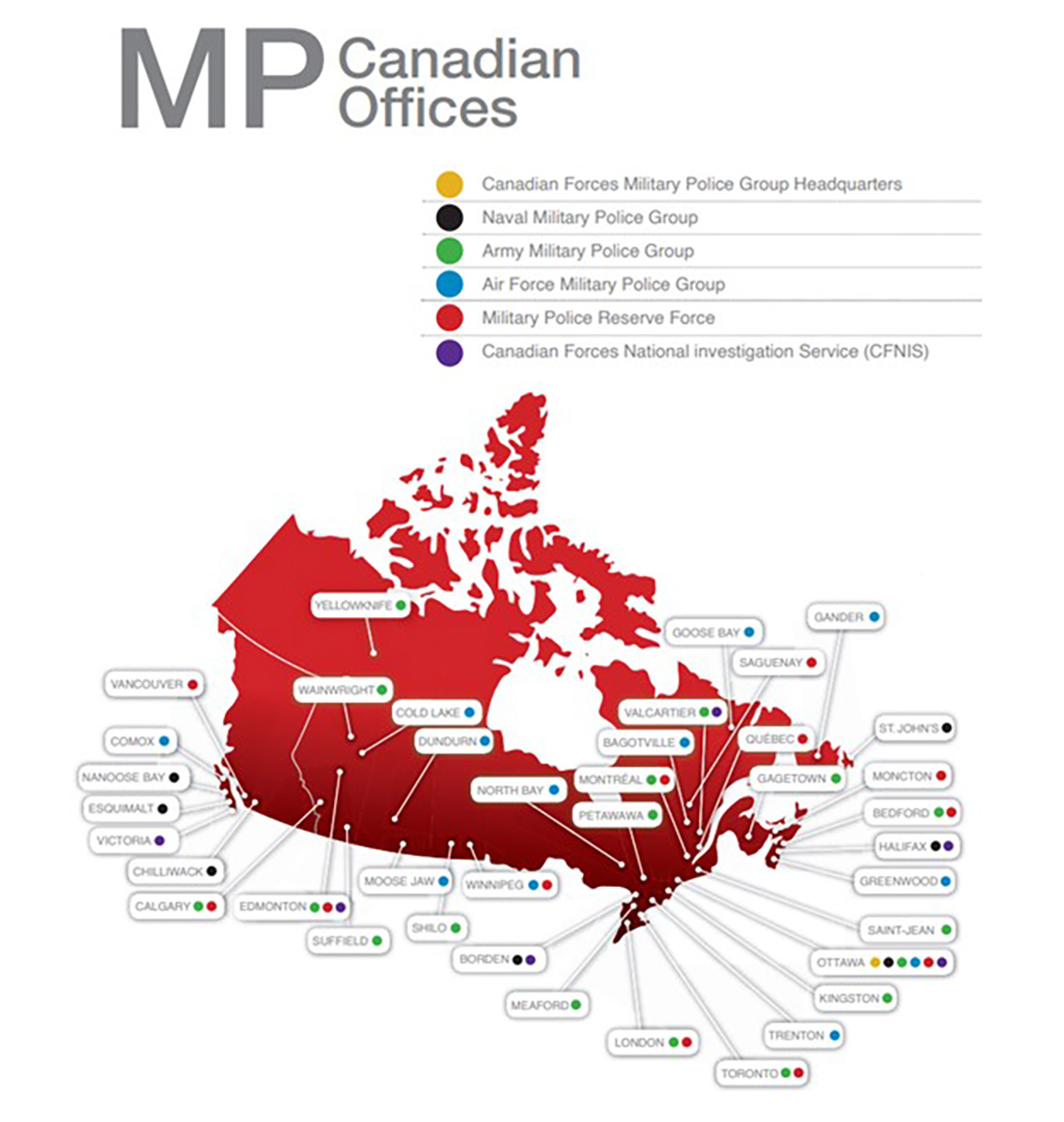
Text version
A map of Canada illustrates the cities in each province where military police group units are located. They are:
- The Naval Military Police Group has units in
- Nanoose Bay, Chilliwack B.C.; and Esquimalt in British-Colombia (B.C.);
- Borden and Ottawa in Ontario (Ont.);
- St. John’s Newfoundland and Labrador (N.L.);
- and Halifax, Nova-Scotia (N.S.).
- The Army Military Police Group has units in
- Calgary, Edmonton, Suffield and Wainwright in Alberta (Alta.);
- Shilo in Manitoba (Man.);
- Meaford, London, Toronto, Kingston, Petawawa and Ottawa in Ont.;
- Saint-Jean-sur-Richelieu, Valcartier and Montréal in Que.;
- Gagetown New-Brunswick (N.B.);
- and Bedford in N.S.
- The Air Force Military Police Group has units in
- Comox, B.C.; Cold Lake in Alta.;
- Moose Jaw and Dundurn in Saskatchewan (Sask.);
- Winnipeg in Man.;
- Trenton, North Bay and Ottawa in Ont.;
- Bagotville in Que.;
- Greenwood in N.S.; and,
- Gander and Goose Bay in N.L.
- The Military Police Reserve Force has units in
- Vancouver B.C.;
- Calgary and Edmonton Alta.;
- Winnipeg Man.;
- London, Toronto and Ottawa in Ont.;
- Québec city, Saguenay and Montréal in Que.;
- Bedford N.S.; and,
- Moncton N.B.
- The Canadian Forces National investigation Service has units in
- Victoria B.C.;
- Edmonton Alta.;
- Borden and Ottawa in Ont.;
- Valcartier in Que.; and
- Halifax N.S.
- The Canadian Forces Military Police Group Headquarters is located
- in Ottawa, On
Annex D – Map - MP Support to Caf Named Operations
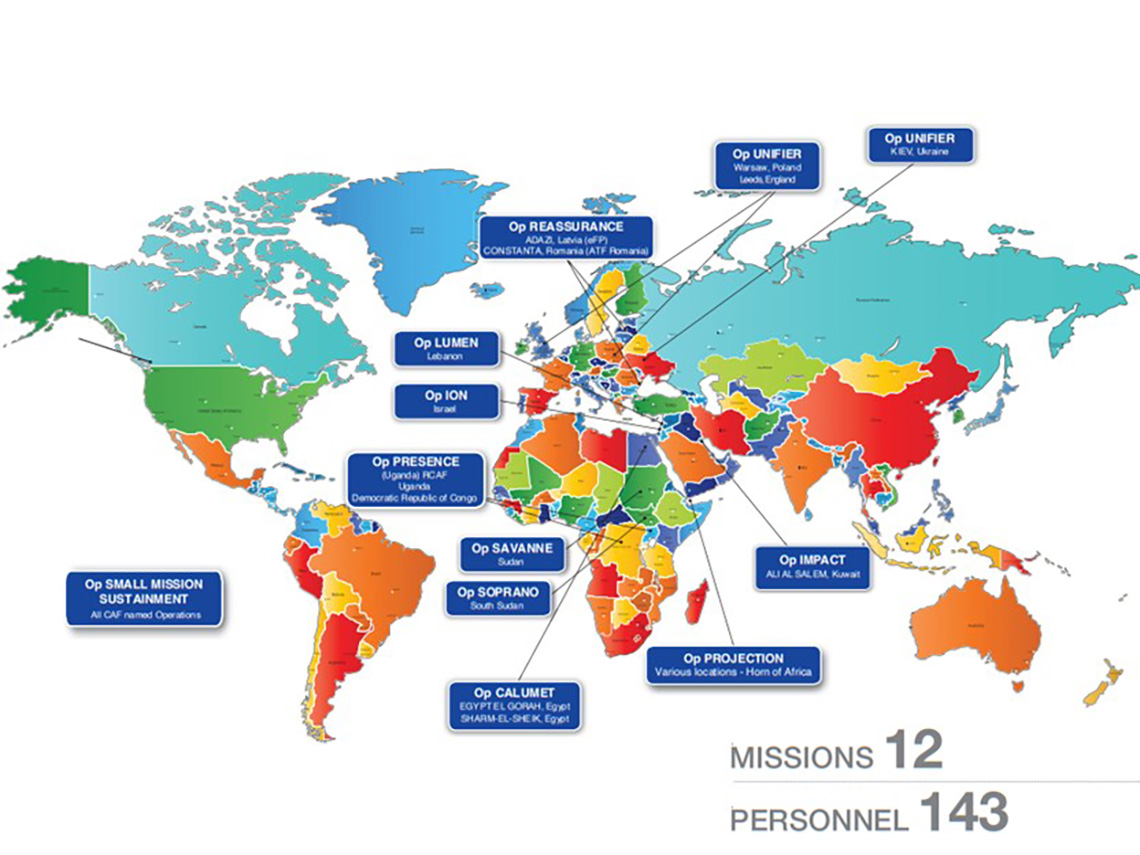
Text version
A political map of the world illustrates in which military operations are Canadian military police personnel deployed. They are:
- Op REASSURANCE - Adazi, Latvia eFP, Constanta, Romania ATF Romania
- Op IMPACT - Ali Al Salem, Kuwait
- Op UNIFIER - Kiev, Ukraine
- Op UNIFIER - Warsaw, Poland. Leeds, England.
- Op LUMEN - Lebanon
- Op ION - Israel
- Op SOPRANO - South Sudan
- Op PRESENCE - (Uganda) RCAF Uganda, Democratic Republic of Congo.
- Op SAVANNE - Sudan
- Op CALUMET - Egypt El Gorah, Egypt. Sharm-El-Sheik, Egypt.
- Op PROJECTION - Various locations - Horn of Africa.
- Op SMALL MISSION SUSTAINMENT - All CAF named Operations.
143 Military police personnel were spread over 12 missions.
Annex E – Map – Military Police Security Service (Mpss) Disposition
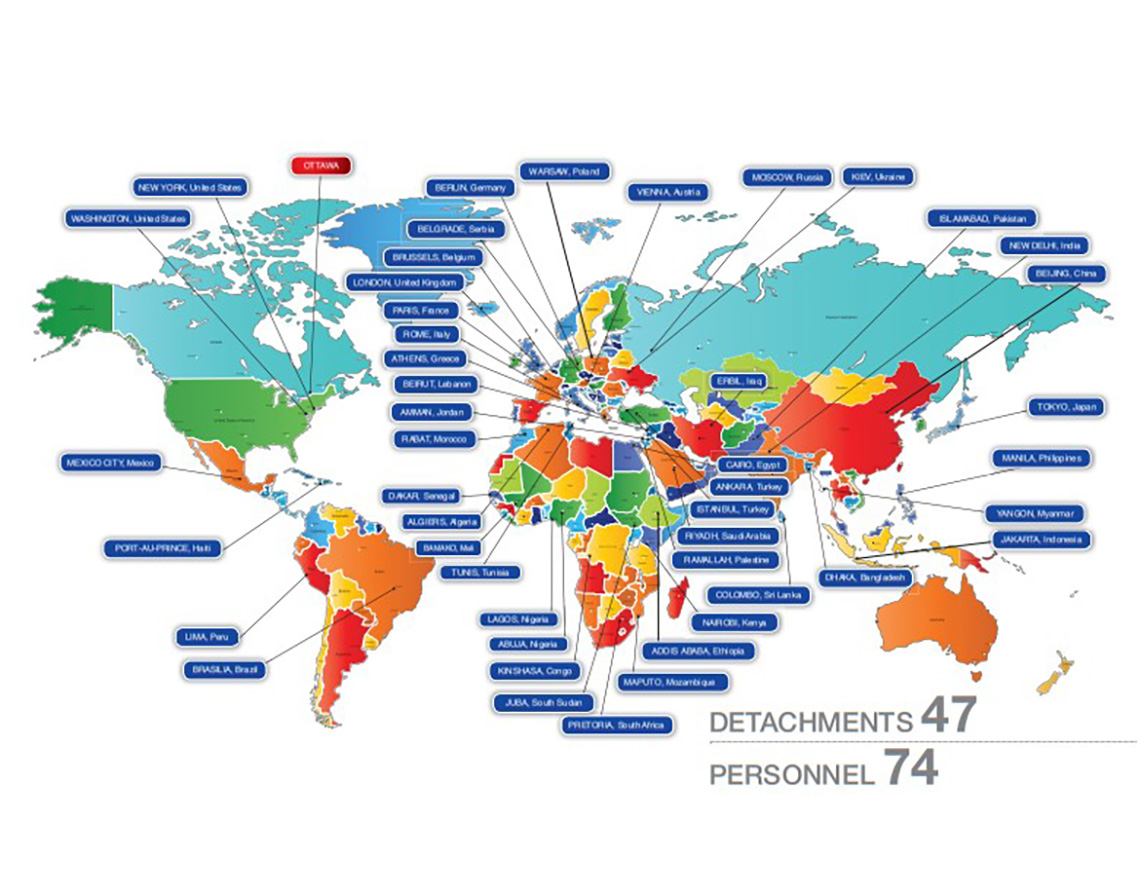
Text version
A political map of the world illustrates in which cities Canadian military police detachments and/or personnel are present. They are:
- Abuja, Nigeria
- Addis Ababa, Ethiopia
- Algiers, Algeria
- Amman, Jordan
- Ankara, Turkey
- Athens, Greece
- Bamako, Mali
- Beijing, China
- Beirut Lebanon
- Belgrade, Serbia
- Berlin, Germany
- Brasilia, Brazil
- Brussels, Belgium
- Cairo, Egypt
- Colombo, Sri Lanka
- Dakar, Senegal
- Dhaka, Bangladesh
- Erbil, Iraq
- Islamabad, Pakistan
- Istanbul, Turkey
- Jakarta, Indonesia
- Juba, South Sudan
- Kiev, Ukraine
- Kinshasa, Congo
- Lagos, Nigeria
- Lima, Peru
- London, United Kingdom
- Manila, Philippines
- Maputo, Mozambique
- Mexico City, Mexico
- Moscow, Russia
- Nairobi, Kenya
- New Delhi, India
- New York, United States
- Paris, France
- Port-au-Prince, Haiti
- Pretoria, South Africa
- Rabat, Morocco
- Ramallah, Palestine
- Riyadh, Saudi Arabia
- Rome, Italy
- Tokyo, Japan
- Tunis, Tunisia
- Vienna, Austria
- Warsaw, Poland
- Washington, United States
- Yangon, Myanmar
A total of 47 detachments and 74 personnel are present across the globe.

